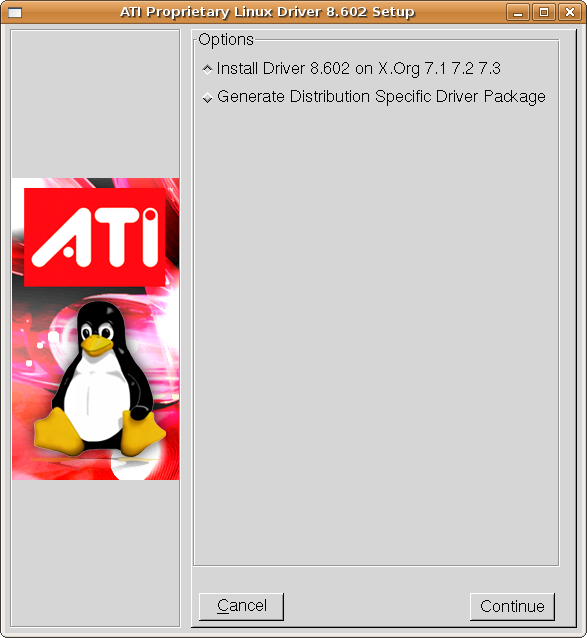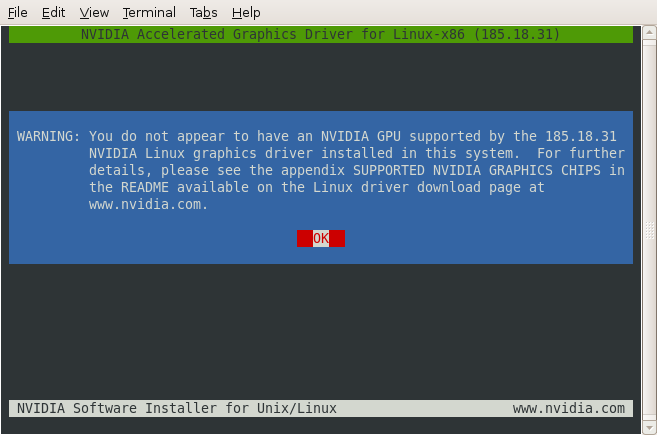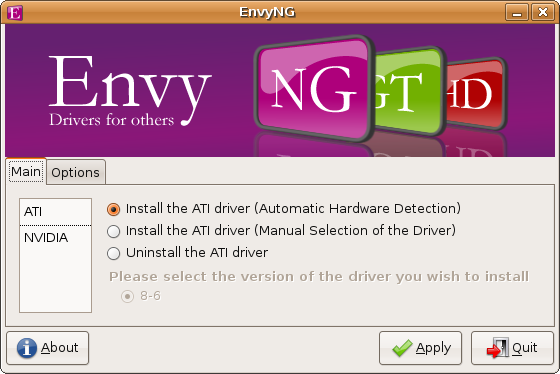Revisiting Linux Part 1: A Look at Ubuntu 8.04
by Ryan Smith on August 26, 2009 12:00 AM EST- Posted in
- Linux
A Word on Drivers and Compatibility
As we mentioned earlier, Ubuntu and the Linux kernel are open source projects, particularly under the GPL license. In large part due to the philosophies of the GPL, compared to Mac OS X and Windows, Linux handles drivers in a notably different fashion.
In a nutshell, the developers of the Linux kernel believe in the open source movement and wish for all related software to be open source. Furthermore they do not like the implications of attaching a closed source “binary blob” driver to the Linux kernel, because if something goes wrong it can be impossible to debug the issue if it occurs in the driver for which they do not have the code for. As such they have moral and technical objections to the Linux kernel supporting external drivers and actively prevent the creation of such drivers. This is done through mechanisms such as not having a fixed API for external drivers, and by not artificially keeping themselves from making changes to the kernel that would break external drivers. Drivers that they do have the code for can usually just be recompiled against the new kernel and are unaffected as a result. The result is that “binary blob” drivers are systematically opposed.
For the most part, this works fine. Not all hardware is supported under Linux because not everyone is willing to share the specifications and data needed to make a driver, but more than enough device manufacturers are willing to share such data that Linux generally supports non-esoteric hardware quite well. There is one class of notable hold-outs here however, and that’s the GPU manufacturers, namely ATI and NVIDIA.
Compared to other drivers, GPU drivers are different for two reasons. First is the sheer complexity of the drivers - besides interfacing with the hardware, the drivers are responsible for memory management, compiling/optimizing shader code, and providing a great deal of feedback. This in essence makes GPU drivers their own little operating system – one that its developers aren’t necessarily willing to share. The second significant difference here is because of the above, GPU drivers are among the only drivers that have a compelling reason to be updated regularly; they need to be updated to better support newer games and fix bugs in the complex code that runs through them.
Complicating matters further is that some intellectual property in GPUs and drivers is not the property of the company who makes the GPU. AMD doesn’t own everything in their Universal Video Decoder, and just about everyone has some SGI IP in their drivers. In the interest of protecting that IP, it is difficult to release the code for those drivers containing other companies’ IP.
Because of all of this, manufacturer-supplied GPU drivers are not always open source. Intel and S3 do well in this respect (largely because they have few tricks to hide, I suspect), but hyper-competitive NVIDIA and AMD do not. AMD has been looking to rectify this, and back in 2007 we discussed their starting work on a new open source driver. Development has been progressing slowly, and for the R6xx and R7xx hardware, the open source driver is not yet complete. Meanwhile NVIDIA has shown no real interest in an open source driver for their current hardware.
So if you want to use a modern, high-performance video card with Linux, you have little choice but to also deal with a binary blob driver for that card, and this becomes problematic since as we mentioned Linux is designed to discourage such a thing. Both AMD and NVIDIA have found ways around this, but the cost is that installing a binary driver is neither easy, or bug free.
The fundamental method that both use for accomplishing this is through the use of a kernel shim. Both analyze the headers for the kernel to identify how the kernel is organized, then they compile a shim against that kernel. The shim resolves the issues with the lack of a stable API, and the other end of the shim provides the stable API that NVIDIA and ATI need.
Ubuntu in particular takes this one step further, and in the interest of promoting greater out of the box hardware compatibility, includes a version of the binary drivers with the distribution. This is unusual for a Linux distribution and has earned Ubuntu some flak since it’s not strictly adhering to some open source ideals, but it also means that we were not forced to play with driver installers to get Ubuntu fully working. Ubuntu had no issues with both our AMD 2900XT and NVIDIA 8800GTX cards, both of which were picked specifically because we wished to test Ubuntu on suitably old hardware which would exist in time for Ubuntu to include support for it. With that said, the drivers Ubuntu includes are understandably old (once again owing to the idea of a stable platform) which means we can’t avoid installing drivers if we want better performance and application compatibility.

And this is where “easy” comes to an end. We’ll first start with AMD’s installer, the easier of the two. They have a GUI installer that puts in a driver along with a Linux version of the Catalyst Control Center. It’s Spartan, but it gets the job done.
NVIDIA on the other hand does not have a GUI installer – their installer is a text mode installer that requires shutting down the X server (the GUI) in order to install. It’s difficult to understate just how hard this makes driver installation. Not only is doing all of this completely non-obvious, but it requires interfacing with the CLI in a way we were specifically trying to avoid. It’s something that becomes bearable with experience, but I can’t call it acceptable.

Driver upgrades are an issue on both sides, because the installers are not completely capable of finding and eliminating older versions of the binary drivers. In one instance, for the NVIDIA drivers we had to track down a rather sizable shell script that automatically deleted the old drivers before installing the new ones, as that was deemed the “right” way to install the drivers. We had less of an issue with ATI’s drivers, but to be fair the primary card I used for my time with Ubuntu was the 8800GTX. I can’t confidently say that there are not other issues that I may have not run in to.
The Ubuntu community does supply tools to help with GPU driver installations, Once such tool is EnvyNG, which reduces the driver installation process to selecting what driver you want to install and it does the rest. This is a far easier way to install drivers, in the right situation it’s even easier than it already is under Windows. But it suffers from needing to have the latest driver data hardcoded in to it, which means you can only use it to install drivers it knows about, and nothing newer. It’s not regularly updated (as of this writing the latest driver versions it has are NV 173.14.12 and ATI Catalyst 8.6) so it’s good for installing newer drivers, but not the newest drivers.

The other tool is access to Ubuntu’s Personal Package Archives, which are a collection of user-built binaries that can be installed through the Ubuntu package manager (more on this later). It’s harder to use than EnvyNG, but anyone can build a PPA, which makes updates more likely. As it’s user-generated however, this still means that there won’t always be the latest drivers available, which means we’re still back to using ATI and NVIDIA’s installers.
As it stands, installing new GPU drivers on Ubuntu is between an annoyance and unbearable, depending on how many hoops you need to jump through. It’s certainly not easy.
The other problem with GPU drivers is that they do not always stay working. Among the issues we encountered was ATI’s driver failing to work after installing an Ubuntu update, and an NVIDIA driver that kept rebooting the system during testing for reasons we never determined (once we wiped the system, all was well).
Our final issue with the state of GPU drivers on Ubuntu is their overall quality. With a bit of digging we can come up with issues on both sides of the isle, so it’s not as if either side is clean here. But with that said, we only ended up experiencing issues with ATI’s drivers. We encountered some oddities when moving windows that was eventually fixed in the Catalyst 9.3 drivers. It turns out that the problem was that ATI’s drivers lacked support for redirected OpenGL rendering; Linux guru Phoronix has a great article on what this is, including videos, that explains the importance of this change.
Ultimately we hate to sound like we’re beating a dead horse here, but we can’t ignore the GPU driver situation on Ubuntu (and really, Linux as a whole). The drivers have too many issues, and installing newer drivers to fix those issues is too hard. Things could be worse, Ubuntu could only distribute driver updates with OS updates ala Apple, but they could also be better. For the moment it’s the weakest point for Ubuntu when it comes to installing it on a high-end system.










195 Comments
View All Comments
Guspaz - Wednesday, August 26, 2009 - link
"Not that it would necessarily be of much use, the last time I saw any statistics for instant messaging network usage, the vast majority of North American users were on AOL’s AIM network."IM use is highly regionalized. As such, AIM is clearly the dominant IM in the USA. However, Canada is dominated by MSN Messenger, and has been for many years (most of us migrated from ICQ to MSN around the release of Windows XP, I believe, due to the bundling of then Windows Messenger).
So, if Canada is dominated by MSN, while I can't speak for Mexico, it's misleading to claim that "the vast majority of North American users". As a Canadian, I can't think of anybody I know in person that uses AIM. They all use MSN or Google Talk without exception.
Aclough - Wednesday, August 26, 2009 - link
For myself, the thing that most bugs me when I have to go back to Windows is all the missing features from the window manager. I've come to rely on having multiple workspaces on my desktop, but I can adjust to having just one fairly easily when I'm not working on a lot of different stuff at once. What really bugs me, though, is how much more effort it takes to move or resize windows in Windows. On Linux I can press ALT and then click anywhere on the window, but with Windows I have to carefully click the title bar or the very edge of the window and that takes a noticeably longer time once you're used to doing things differently.Oh, and I find that the Linux scheduler seems to be noticeably better than the Windows one in preserving responsiveness when the system is under load.
fumacapena - Wednesday, August 26, 2009 - link
Great article!How about some benchmarks of "minimal" distros (like Puppy, Tine Core, ...)??
I like the idea of "ressurect" an old PC, but I would like to see benchmarks in Quad Cores, i7 too!
Anandtech is great, Bench(beta) is awesome!!
(sorry by bad english)
Thanks
InGraphite - Wednesday, August 26, 2009 - link
A few months ago most major trackers unbanned Transmission, but it still doesn't seem to be universally accepted on private trackers.I remember offhand (I could be wrong) that the main gripe was due to the fact it made excessive queries and thus flooded trackers with requests, or had the ability to.
chomlee - Wednesday, August 26, 2009 - link
I think you really need to mention the big picture here.I myself just tried Ubuntu for the first time 2 months ago and although I will admit that I have spent up to 8 hours trying to figure out how to install a specific program (before I found out there was a way to get the package manager to find the install), and I wanted to smash my computer at times. Now that I have learned quite a bit more, I realized that the few things I have installed worked great and flawlessly.
Anyhow back to the big picture. I can understand some of your concerns with how the OS will work with specific programs but what I have found is that most people I know use their computers for 2 things email and web browsing. Most of these people are constantly having problems with the system running too slow and cant seem to get rid of hidden viruses/malware. So I think that those people could easily be much happier with a simple OS like Ubuntu just for email and web browsing (And I would get a heck of alot of less calls from my dad asking my why his computer is running too slow). Lets also not forget that everything is moving to be browser compatible (like you mentioned).
Also, for people like myself, I use my Ubuntu system for a file server as well as a media center (XBMC is Awesome).
So, yes, for burning DVDs/CDs/Playing Games/Microsoft Office, I see no reason why you wouldn't use windows, but I think 95% of the users would be perfectly fine with ubuntu which is something that Mr Bill would not be very happy about when the public realizes this.
Keno - Thursday, August 27, 2009 - link
I think you have missed one small but important part.I am Ubuntu user since 8.04. I came to Linux because of the constant treat of viruses.
Last month I have installed 7 and it is very user friendly and I think it is very user frinedly but after Avira Antivir got crashed by virus I installed Kaspersky INternet security 2010. then it took almost twice as long to boot. Then I gladly returned to Ubuntu 9.04. Because MIcrosoft can not exist without Antivirus I think you should do some real benchmarking and test windows WITH Antivirus.
On Ubuntu I have ClamWin just in case i get some files from Windows users:)
Thanks
ioannis - Wednesday, August 26, 2009 - link
just wanted to point out that you can install software under the LiveCD. Of course it does not install on the hard drive. It remains on a ram-drive, so when you reboot, it's gone. It's still useful, if you wish to test out some package or perform some task with a tool not installed by default on the LiveCDstrikeback03 - Wednesday, August 26, 2009 - link
Even more useful (and not mentioned) is that Ubuntu can easily run off a flash drive, and more recent versions even include a GUI tool for installing it to one. Then all installs and other changes are saved from session to session, and everything runs much more quickly than the LiveCD.Mr Pearce - Wednesday, August 26, 2009 - link
It would be great if you could do more articles on compiler and especially driver performance differences. That was the most interesting part of this article.Ryan Smith - Wednesday, August 26, 2009 - link
This is what Part 2 will look at. I can compile some stuff by hand to see if it closes the Windows/Ubuntu gap, and I have plenty of video cards on hand to test what I can when it comes to graphics.